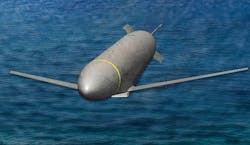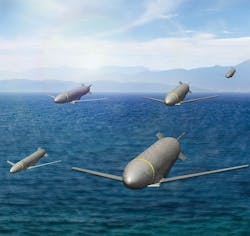Lockheed Martin engineering networked, collaborative missile capable of swarming for Air Force
DALLAS. Lockheed Martin (NYSE:LMT) Missile and Fire Control engineers in Dallas, Texas, are developing Gray Wolf, an innovative cruise missile capable of networked, collaborative maneuvers to enable swarming. Lockheed Martin engineers will design, develop, and demonstrate the new low-cost cruise missile -- which resembles an unmanned aircraft system (UAS) or drone -- under a $110 million, five-year Phase 1 contract from the U.S. Air Force Research Laboratory (AFRL) at Wright-Patterson Air Force Base (AFB) in Ohio.
Gray Wolf will operate in highly contested environments, and will be capable of collaborative, networked "swarming" behaviors to address air-defense system threats.
The Gray Wolf program is intended to develop and demonstrate low-cost, subsonic cruise missiles that use open architectures and modular design to enable maximum mission flexibility, rapid prototyping, and spiral growth or upgradable capabilities. The AFRL is developing the missiles to feature networked, collaborative behaviors to facilitate swarming and to address Integrated Air Defense (IAD) system threats around the world.
"Lockheed Martin's concept for the Gray Wolf missile will be an affordable, counter-IAD missile that will operate efficiently in highly contested environments," says Hady Mourad, Advanced Missiles Program director for Lockheed Martin Missiles and Fire Control. "Using the capabilities envisioned for later spirals, our system is being designed to maximize modularity, allowing our customer to incorporate advanced technologies such as more lethal warheads or more fuel-efficient engines, when those systems become available."
The Gray Wolf program consists of four spiral-development phases that allow for rapid technology prototyping and multiple transition opportunities. This first phase, defined by an indefinite delivery/indefinite quantity (IDIQ) contract, is anticipated to run until late 2019. Initial demonstrations will be from an F-16 aircraft. In addition to the F-16, the system will be designed for compatibility with F-35, F-15, F-18, B-1, B-2, and B-52 aircraft.
"Our AFRL customer will benefit from decades of Lockheed Martin experience in building high-quality, low-cost systems like GMLRS, while capitalizing on the experience of our team in developing and integrating advanced cruise missiles such as JASSM and LRASM on military aircraft," Mourad adds.
Headquartered in Bethesda, Maryland, Lockheed Martin is a global security and aerospace company that employs approximately 97,000 people worldwide and is principally engaged in the research, design, development, manufacture, integration, and sustainment of advanced technology systems, products, and services.


